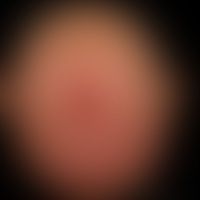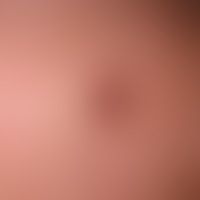Image diagnoses for "red", "Scalp (hairy)"
55 results with 125 images
Results forredScalp (hairy)

Squamous cell carcinoma of the skin C44.-
Squamous cell carcinoma in actinic pre-damaged scalp:Continuously growing keratoacanthoma of the scalp, existingfor about 7months, with a smooth surface and a broad base; multiple actinic keratoses.

Tinea capitis (overview) B35.0
Tinea capitis profunda: Inflammatory, moderately itchy, slightly painful, fluctuating nodule in the area of the capillitium in children with extensive loss of hair.

Squamous cell carcinoma of the skin C44.-
Squamous cell carcinoma of the skin: 1.5 cm large, spherical, red node (tumor) with ulcerated surface and hemorrhagic crust on the forehead of a 67-year-old female patient.

Pilomatrixoma D23.L
Pilomatrixoma, reddish-bluish, in a marginal area whitish, 5 mm large tumor on the hairy head.

Squamous cell carcinoma of the skin C44.-
Squamous cell carcinoma in actinically damaged skin; for more than 1 year, slowly growing, bowl-shaped, very firm, little pain-sensitive, ulcerated lump, which (at the time of examination) was no longer movable on its base.

Tuft hair L66.2
Tufted hairs: Folliculitis decalvans, reflecting scar plate with wicklike hair tufts at the edges (see also under Folliculitis decalvans).

Basal cell carcinoma (overview) C44.-
Basal cell carcinoma, nodular: Development of a basal cell carcinoma on a (congenital) sebaceous nevus. The carcinomatous transformation took place chronically insidiously without any symptoms. Only a recurring crust formation with intermediate weeping led to the pioneering biopsy.

Carcinoma of the skin (overview) C44.L
Carcinoma cutanes:advanced, flat ulcerated exophytic squamous cell carcinoma with massive actinic damage. 82-year-old man with androgenetic alopecia. Pronounced spring carcinoma.

Fibroxanthoma atypical C49; D48.1
Fibroxanthoma atpyisches: rapidly growing, centrally ulcerated, painless lump in a man (>70 years) in actinically severely damaged skin.

Alopecia scarring L66.8

Merkel cell carcinoma C44.L
Merkel cell carcinoma: uncharacteristiccentrally deep ulcerated, plate-like lump, previously calotte-shaped growth.

Lupus erythematodes chronicus discoides L93.0
lupus erythematodes chronicus discoides. alopecia existing for 4 years. multiple, smaller and larger alopecic foci, with centrifugal expansion. in the center larger hairless, scarred area (no evidence of follicular structures). the patient complains of a temporary hyperesthesia of the affected areas. encircles a still active zone of CDLE.

Primary cutaneous cd30 positive large cell t cell lymphoma C86.6

Pemphigus diseases (overview) L10.-
Pemphigus vulgaris: 63-year-old patient with a pemphigus vulgaris (mucocutaneous type) that has existed for 3 years; extensive painful erosions of the capillitium.

Cylindrome D23.4

Dyskeratosis follicularis Q82.8
Dyskeratosis follicularis: 74-year-old woman. large , hyperkeratotic zones with reddish, partly macerated papules and firmly adhering, partly eroded, confluent keratoses on the capillitium and in the facial area preauricularly, existing since early childhood. the patient has a somewhat neglected appearance. the skin lesions have a foetal odour. the lesions increase with sweating or heat, especially in the warm season.

Dyskeratosis follicularis Q82.8
Dyskeratosis follicularis: Infestation of the palms of the hands; in central areas of the palm flat, common keratoses, at the ball of the thumb about 0.1-0.2 cm large, glassy papules.







